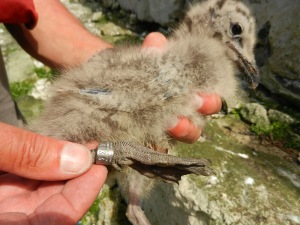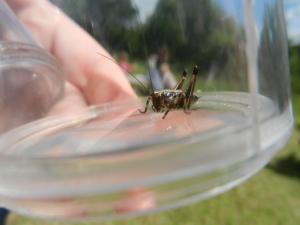Doing too much cool stuff, as usual!
The week began with a bang, or rather it began with squawking and chirping. I was invited out to the Portland Port breakwaters by Steve Hales who takes me birdringing. The Portland Port Authority and the local birdringers (including Steve) were going out there to ring the chicks of Great Black-backed Gulls (GBBG) – the adults of which are the really big and quite scary-looking gulls.
- Two young chicks, too small to ring
- An adult GBBG
- A clutch of gull eggs
The chicks however are adorable – incredibly fluffy when young, and actually still quite cute as they get older. We could only ring chicks of certain ages, i.e. once they were big enough for the ring not to slip off, and before they got too big to put the (coloured) ring on. Two types of ring were involved – a metal ring and a coloured ring, both used for identification purposes as part of the British Trust for Ornithology‘s (BTO) ringing scheme.
The latter ring could only be put on the older of the chicks we were ringing, and we almost couldn’t put it on a couple of them (the method for putting coloured rings on is different than for metal rings, due to the material of the ring). In total, we ringed 28 GBBG chicks. We also ringed a couple of Herring Gull chicks with metal rings, as they were nesting nearby.
So what was the purpose of ringing? By assigning a numbered ring, and thus a specific identification, to each bird, we can keep track of where they are sighted. Through this we can learn more about the different aspects of the bird species – migration patterns, survival rates (both adults and fledgings) and other population information.
I’m very grateful to the birdringers and to the Portland Port Authority for allowing me to go on this trip, it was hugely enjoyable and one of the highlights of my time in Dorset so far.
Back at the Chesil Centre, I helped with a couple of school groups that we had in. First assisting with a low tide walk with 30-ish young primary school children, then leading a group myself of 15 children. I always love working with children as they are very enthusiastic about everything (hmm … does that sound rather like someone?), and I believe it is important to get children interested in wildlife whilst they’re young. Even if they don’t become scientists, they will hopefully retain an appreciation of wildlife and that we should conserve it.
My appreciation for wildlife was heightened during a trip on the Fleet Observer, this is a glass-bottomed boat which runs trips on the the Fleet. During this trip, we got great views of the underwater world, the Little Terns and even some hares (my highlight of the trip).
- Chesil Hares!
- Little Egret
- The skipper’s dog, enjoying the ride
I also helped out with a school group up at Lorton Meadows, with one of my favourite activities – pond dipping! I consider this to be one of the best activities to do with children, as ponds are found everywhere (so what they learn will hopefully be remembered easier) and the underwater world is rather mysterious and amazing. We found a variety of creatures including efts (juvenile newts), water boatman and we also saw some dragonflies darting about. After pond dipping, they had a bug hunt in the grasses and caught some interesting insects.
The week finished off with a dash up to Shropshire for an ecology course. I am taking a few modules every year in ecology with the Lifelong Learning department of Aberystwyth University. Although I have a science degree, it is in a subject that I no longer want to pursue and I want to learn more ecology. So by taking these modules I can gain a wide variety of theory and practical knowledge, and even work towards a Certificate in Field / Conservation Ecology. This module was Ecology 1 – i.e. an introduction to the concepts involved in ecology including nutrient cycles, predator-prey relationships and food webs. Although I remember most of it from school, it was very useful to have it consolidated and drawn together.
- Our carbon cycle, with artistic license.
- I saw a moth! I think it is Silver-ground Carpet
- Discussing different types of soil.
- Lots of cute spiders in the grasses
- Nice feature that I included here for my mum
- A spread-eagled bumblebee
The course location was at Karuna, a gorgeous family project in the Shropshire AONB (Area of Outstanding Natural Beauty). With a passion for trees, permaculture and Insight Design, this is a fabulous example of how living off the land can be done. Whilst not fully self-sufficient, they’re pretty close and it was fascinating to learn from them during the tour. One of the course members described it as “an oasis of hope”, and I thoroughly agree and hope to return there!
Just a quick note about the course tutor – a brilliant ecologist called Dr Jan Martin who seems to be all-knowledgeable! I really enjoy reading her blog which discusses sustainability, and has a brilliant name; The Snail of Happiness.
I do apologise for the long blog post – I guess I must limit the amount of cool stuff that I do! I shall end with a nice photo of the seal that we saw at the Portland Port breakwater.


















Thanks for the shout-out… glad you enjoyed the course!
What an excellent post 🙂 I came visiting from The Snail of Happiness and now I am tired just reading about everything that you did. It’s mid winter here in Tasmania as I tap this comment and it’s lovely to be warm near the fire and reading about other people’s exploits. That’s what makes social media such a great vehicle…it allows you to be content, warm and lazy in the comfort of your own kitchen whilst living vicariously through other people’s hard slog 😉
Haha, I do get up to a lot! And I don’t even include everything in this blog! And agreed, I find that with Snail of Happiness – minimal opportunity to try out much of what she suggests (moving around a lot due to work).
But you certainly do a lot with your “spare time” and its most interesting to read 🙂 Kudos on your excellent blog by the way 🙂
I definitely do! And thank you 🙂
I have just jumped over from Jan’s blog — you are so right about her blog! — and loved reading your post. Your enthusiasm is infectious 🙂
Thank you! Glad to hear that you’re being infected :p
No need to apologise for a long post! It’s your blog and it’s great reading them! I have never done bird ringing. While I would like to experience it, I don’t think it is something I would fully get involved with – birds aren’t really my thing and there are so many other things to do!
Thank you 😀
And agreed, there is so much to do! I’m trying to make the most of my trainee position to experience as much as possible, but still don’t have time to cover everything!